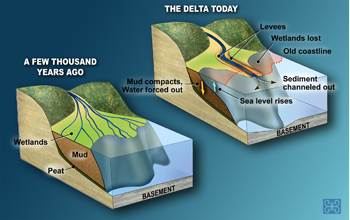Multimedia Gallery
New Findings Account for Unstable Ground (Image 1)
Over thousands of years, the thick, muddy deposit of the Mississippi delta has compacted under its own weight, squeezing water out. As a result, the sea level has risen, covering wetlands.
Research by geoscientists shows that the land 30 to 50 feet beneath much of the Mississippi Delta has been very stable for the past 8,000 years, with low to nonexistent subsidence rates. These findings challenge the notion that subsidence, or sinking of the earth, bears much of the blame for Louisiana's coastal geology problems and suggesting instead that compaction of the shallowest and most recently formed delta sediments is the main cause of subsidence in that area. These findings could have major implications for rebuilding plans that are currently being debated and over the long term, comprehensive understanding of subsidence will better support rational coastal management and successful urban and land-use planning for all low-lying areas along the Gulf Coast.
This image accompanied NSF press release, "Rise in Sea Level, Loss of Wetlands May Account for Unstable Ground in Mississippi Delta." [See related image Here.]
Credit: Zina Deretsky, National Science Foundation
Images and other media in the National Science Foundation Multimedia Gallery are available for use in print and electronic material by NSF employees, members of the media, university staff, teachers and the general public. All media in the gallery are intended for personal, educational and nonprofit/non-commercial use only.
Images credited to the National Science Foundation, a federal agency, are in the public domain. The images were created by employees of the United States Government as part of their official duties or prepared by contractors as "works for hire" for NSF. You may freely use NSF-credited images and, at your discretion, credit NSF with a "Courtesy: National Science Foundation" notation.
Additional information about general usage can be found in Conditions.
Also Available:
Download the high-resolution JPG version of the image. (433 KB)
Use your mouse to right-click (Mac users may need to Ctrl-click) the link above and choose the option that will save the file or target to your computer.



